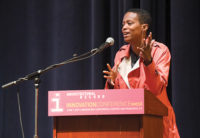The setting, an ornate auditorium in Manhattan’s Masonic Hall, was designed for semi-secret rituals, but the focus of Architectural Record’s latest Innovation Conference was the opposite: ways architecture can improve cities for everyone. Cathleen McGuigan, the editor-in-chief of Architectural Record, started the event, titled The Future of Architecture and the Public Realm, by noting that it was occurring on the 20th anniversary of the opening of Frank Gehry’s Guggenheim Bilbao, which is proof—if anyone needed proof—that architecture can transform a city.
Michael Kimmelman, the architecture critic of the New York Times, recounted some off the challenges of what he called “the first urban century,” including climate change, which, he said, “is going to reshape every place we live.” He described environmental devastation he has seen in cities like Jakarta (“a sunken pool”) and said architects need to rise to the challenges. “These are problems we designed our way into and can design our way out of,” he said, adding that “the world has a profound appetite for the problem-solving skills that only architects can offer.”
Those problem-solving skills were demonstrated by speaker after speaker. Rob Rogers, the founder of New York-based Rogers Partners Architects + Urban Designers, showed a series of projects for pedestrian zones around important public buildings. Bollards outside the New York Stock Exchange are appealing crystalline forms, while, in the firm’s competition-winning scheme, the South Lawn of the White House would be protected by almost imperceptible changes in grade. “You can solve the specific demands of counterterrorism while preserving the public realm,” said Rogers. Chris Reed, the founding director of Stoss Landscape Urbanism, presented work that similarly folded functional solutions into public landscapes—including The Plaza at Harvard University, built on an overpass, and part of a post-High Line crop of public spaces that make the most of their entanglements with infrastructure. Reed, who attended grad school in the 1990s, said “I’m part of a generation of designers who have never worked on a greenfield site.”
The architects Marion Weiss and Michael Manfredi of Weiss/Manfredi Architecture/Landscape/Urbanism described their efforts to enhance the public realm. Their architecture building at Kent State University reaches out to the community in a way that “gives the private work we do as architects a public dimension,” Manfredi said. And their Bridge Building, part of the Cornell Tech campus on Roosevelt Island, splits open in a way that makes it not an object in the landscape but an extension of that landscape.
Sharon Johnston and Mark Lee, of Los Angeles-based Johnston Marklee & Associates, described several museum projects that create or improve public spaces, including their Menil Drawing Institute in Houston (scheduled to open next year), which works with two other buildings to form a serene park. Johnston said that some of the best public spaces are under-programmed, under-determined,” allowing users to fill in the blanks.
Brendan MacFarlane, of the Paris-based Jakob + MacFarlane, agreed. He described two projects, in Paris and Lyons, that have changed those cities’ relationships to their rivers. He proved it with a series of Instagram photos taken by visitors to the waterfront buildings. “These images are not us. What we created becomes background, a place for other ideas. You make a move and it incites other moves. To an architect, that’s fantastic.”
Shohei Shigematsu, who runs the 85-person New York office of OMA, showed public projects like the Faena Forum, a cultural center in Miami Beach, and a bridge proposed for Washington, D.C., with a cafe and performance spaces. “It’s like the Rialto Bridge in Venice,” he joked, “with a little more program.” In Menlo Park, California, Shigematsu is master-planning a new campus for Facebook that eschews suburban office park conventions—“we are trying to create urban fabric, to stitch this back into the city,” Shigematsu said.
But first the city needs to survive. Amy Chester, the managing director of Rebuild by Design, spoke with Simon David of Bjarke Ingels Group, about the “Big U,” its plan for protecting Lower Manhattan from storm surges, and David Waggonner of Waggonner & Ball, about its resiliency plans for New Orleans and Bridgeport, Connecticut. In each case, Waggonner said, the projects require meetings with myriad agencies. In a description of those meetings that could just as easily have applied to the RECORD conference, Waggonner said, “If we’re in the room, it’s because we want to make a difference through design.”




